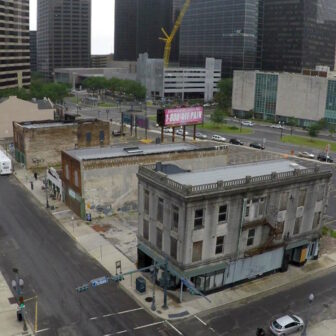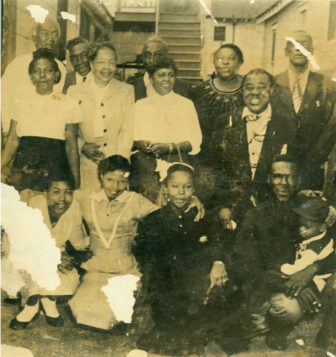
New Orleans is the cradle of jazz, the birthplace of American music. What have been called the three most important jazz landmarks on the planet — the Eagle Saloon, Iroquois Vaudeville Theater and Karnofsky Tailor Shop — occupy the 400 block of South Rampart Street like islands in a sea of parking lots.
To the average passerby they may look like candidates for the wrecking ball. But these dilapidated walls, enclosing places where jazz was first played, have much to tell us about the creation of American music.
At the Eagle Saloon, around 1900, Buddy Bolden’s clarion call signaled the emergence of a new music form, drenched in American blues and ragtime but also something that sounded altogether different: jazz. After Bolden left the scene his mates continued as the Eagle Band and based themselves at the saloon.
Up the street past a parking lot is the Iroquois Vaudeville Theater, almost certainly the first stage that Louis Armstrong ever appeared on when he won a talent contest as a kid. Jelly Roll Morton played there; Bessie Smith, too. More importantly, black vaudeville in places like the Iroquois is how jazz spread before it was first recorded in 1917.
Louis Armstrong grew up in this neighborhood and worked for a Lithuanian Jewish family named Karnofsky who maintained several businesses in the area, including the still standing (barely) tailor shop on Rampart. They were dear to Armstrong and he wore a star of David around his neck in part as a tribute to them. He said he learned to sing from his heart with the Karnofskys.
It was at the corner of Rampart and Perdidio streets that an 11-year-old Armstrong would famously fire a gun in the air to ring in 1913. He was arrested, as he had been previously for other offenses, and taken to the Colored Waif’s Home. That was a milestone event in his life. He learned to play the horn there as part of the Waif’s Home band. It set him on the trajectory that made him, by many accounts, the most important figure in 20th-century American music.
There it is. Three buildings in one block in the cradle of jazz, landmarks that trace the music from its alpha, with Bolden, to its apex, with Armstrong. Saving these structures seems a no-brainer in a city developing its economy around cultural tourism.
So the announcement, on Friday, that plans are afoot to stabilize at least one of these buildings, the Eagle Saloon, comes as good news. But can we believe it?
Today these essential landmarks remain firmly in the hands of gold-plated landlords who — defying years of pressure from preservationists — have failed to keep them in a respectable state of repair.
The Eagle Saloon is literally listing. If it were a ship, the lifeboats would be deployed about now. (Part of the Eagle collapsed into the street in 2005). It could fall today, but if not repaired it will surely fall on an upcoming tomorrow.
All this is coming to a head now behind an apparent preservation effort calling itself “Bring Back the Eagle Saloon.” I say apparent because circumstances suggest this effort to date has been nothing more than smoke and mirrors, less likely to save the Eagle than to ensure its continuing demolition by neglect.
… the Meraux Foundation had been trying to finance this effort on the good will and bankrolls of millennial hipsters who have no clue about the foundation’s infamous history with these buildings.
The building is owned/controlled on paper by something calling itself the “New Orleans Music Hall of Fame, LLC.” A closer inspection of the LLC’s documents show that the administrators — i.e. owners of the would-be Hall of Fame — are Floyd and Rita Gue, the same duo who oversee the Arlene and Joseph Meraux Charitable Foundation, the entity that for decades has presided over the accelerating decay of the Iroquois and Karnofsky landmarks.
The Gues appear to have regained control of the saloon property, which, in 2007, Meraux sold for $800,000 to the late Jerome “PoppaGee” Johnson, founder of the New Orleans Music Hall of Fame.
Johnson reportedly was awarded $1.3 million in city funds for a building restoration that never occurred. Preservationists secured landmark status for all three buildings in 2009 and two years after that, under pressure to save the structures, Rita Gue announced that she had buyers for the tailor shop and vaudeville theater and would close on the deal “in 60 days.”
Didn’t happen.
In a statement accompanying the new initiative, Rita Gue said Johnson, on his deathbed, appointed her to serve on the Hall of Fame’s board and “prevent the organization from going into legal limbo.” She noted that the Meraux Foundation has donated to the Music Hall of Fame the $800,000 Johnson paid for the saloon building.
So in the end we’re left to wonder if this round-robin of buying and donating hasn’t kept the buildings in the hands of the very same folks that the buildings need to be saved from.
Despite its fat wallet, prior to Friday’s announcement the Meraux Foundation had been trying to finance this effort on the good will and bankrolls of millennial hipsters who have no clue about the foundation’s infamous history with these buildings.
Gue said she was pleased to have succeeded in recruiting “musical legends including Deacon John, Big Sam and George Porter Jr., to serve as “cultural ambassadors.” I need convincing it’s not just a cynical ploy to lend credibility to the campaign.

Elsewhere in this country buildings are declared landmarks because George Washington slept there one night or an unfortunate president took in his last play in a balcony seat. I’m not saying those aren’t places worthy of honor. My question is this: Isn’t proper restoration of the birthplace of jazz just as important?
Rampart Street in the early 20th century is where American culture was forged and its most distinctive vocabulary created. Imagine American music without the influence of Louis Armstrong. Imagine there being a Louis Armstrong without his New Orleans nativity. Now try to imagine New Orleans without Armstrong.
On an otherwise obliterated Backatown landscape, these buildings are the last tactile link to that musical seedbed. We tore down Armstrong’s two homes, built City Hall on one and traffic court on the other.
To avoid the same fate, the Eagle Saloon must be saved, along with the Iroquois Theater and Karnofsky Tailor Shop. Yet to my mind any effort in that direction involving the current ownership, the very people responsible for the decades of destructive neglect, should give us pause. Yes, save the Eagle Saloon, but from whom?
John McCusker is a New Orleans native and retired photojournalist. He is the author of “Creole Trombone: Kid Ory and the Early Years of Jazz” and founder of the Cradle of Jazz History Tour. He can be reached at ory1886@yahoo.com

